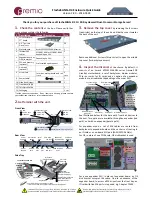
Configuring ENET settings
To configure the ENET settings:
1
From the desktop menu, click
System Setup
, and then click
Network Setup
.
The
Network Setup
dialog box is displayed.
2
Click the
ENET
tab, and use the following guidelines:
a
Ethernet Speed
—Normally the default (
Auto-Detect
) should be selected, but another selection can be made if automatic
negotiation is not supported by your network equipment. The selections include
Auto-Detect
,
10 MB Half-Duplex
,
10 MB Full-
Duplex
,
100 MB Half-Duplex
,
100 MB Full-Duplex
, and
1 GB Full-Duplex
.
The
10 MB Full-Duplex
option can be selected locally at the device, however, this mode may need to be negotiated through
AutoDetect
.
b The
IPV4
check box is selected by default. Click
Properties
to set various options supported by IPV4.
•
Dynamically allocated over DHCP/BOOTP
—Selecting this option enables your thin client to automatically receive
information from the DHCP server. The network administrator must configure the DHCP server using DHCP options to
provide information. Any value provided by the DHCP server replaces any value entered locally on the Options tab, however,
locally entered values are used if the DHCP server fails to provide replacement values.
•
Statically specified IP Address
—Select this option to manually enter the IP Address, Subnet Mask, and Default Gateway:
•
IP Address
—Must be a valid network address in the server environment. The network administrator must provide this
information.
•
Subnet Mask
—Enter the value of the subnet mask. A subnet mask is used to gain access to machines on other subnets.
The subnet mask is used to differentiate the location of other IP addresses with two choices: Same subnet or other
subnet. If the location is other subnet, messages sent to that address must be sent through the Default Gateway,
whether specified through local configuration or through DHCP. The network administrator must provide this value.
Networks
13












































